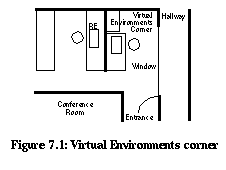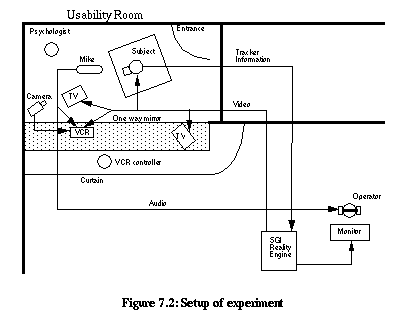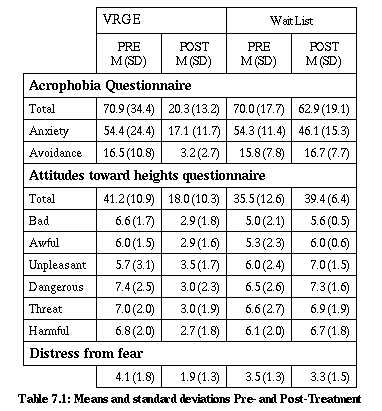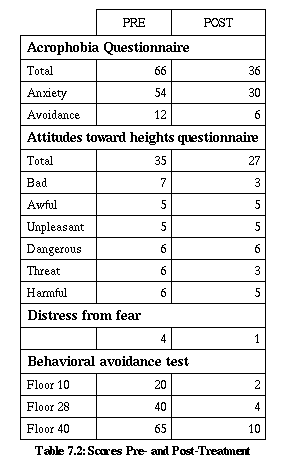
Setup used for experiments
The place where the testing was done (see Figure
7.1) has no privacy at all. People can look inside through the
windows, or when they want to walk to their workplace, they have to
pass the setup. This was acceptable during testing. With the
demonstrations, it was even desirable that as many people as possible
could see it. But with the experiments, the level of privacy had to
be increased.


Outside the usability room, a member of the Virtual Environments group would look after the video recorder. The video recorder was used to tape the subject in the usability room, the virtual environment the subject is looking at and the audio from the usability room. Whenever there was a problem with the communication between the psychologist inside the usability room and the operator, this person could also be used as a runner between the operator and the psychologist.
The subject stood in the mock up of the elevator wearing the HMD inside the usability room. The information from the tracker was now sent directly to the SGI Reality Engine, which calculated the images. Unlike the testing of the environments, there was no longer a second machine necessary. The disadvantage of this setup was that it was no longer possible to use audio in the environments, the SGI Reality Engine has no audio capabilities.
The psychologist was also in the usability room. He could watch how the subject was doing in the virtual environment and watched the virtual environment on the TV screen. When the subject was ready, the psychologist would tell the operator to "teleport" the subject to the next level.
Also in the usability room was a normal TV camera that was operated by the person watching over the video recorder. This camera was pointed at the subject. There was also a microphone in the usability room. Output from this microphone was sent to both the operator and the video recorder.
Group experiment
The first experiment was started in October 1993 and lasted until
December of the same year. This experiment used two groups, one group
that would get treatment by using VR Graded Exposure and one group
that would not be treated. The following section will describe how the
experiment was set up and how the people were selected. The next
section will give some results. The results can be split in two
groups, those that have to do with the efficacy of the treatment, and
those that have to do with presence.
Experiment
This section will describe the setup of this experiment. First the
subjects were selected and put in a group. Next the experiment was
done and finally the results of the two groups were collected.
The subjects that entered the study got a number. This number would be their subject number and was used to insure confidentiality. The subjects were randomly assigned to either a treatment (VRGE) group or a wait-list control (WL) group. The VRGE group was treated for acrophobia using the environments described in the previous chapter. After the treatment, the results were compared with the WL group who did not get any treatment. After the experiment, the WL group was offered the possibility to be treated with VR.
The Acrophobia Questionnaire (see appendix A-3), [cohen 77] describes twenty situations with rating scales for anxiety (0-6) and avoidance(0-3). The Acrophobia Questionnaire yields a total score ranging from 0-180 and anxiety (0-120) and avoidance (0-60) subscale scores. Adequate consistency and test-retest have been previously demonstrated, and it has been shown to discriminate between phobic and nonphobic subjects [cohen 77]. The questionnaire has been proven to be more sensitive to treatment outcome than behavioral tests [cohen 77].
The Attitude Towards Heights Questionnaire (see appendix A-4) contains six items assessing attitudes towards heights and was adapted from Abelson and Curtis. These include the following dimensions rated on a 0-10 semantic differential scale: good-bad, awful-nice, pleasant-unpleasant, safe-dangerous, threatening-unthreatening, and harmful-harmless.
The Fear Questionnaire (see appendix A-5) was constructed for use in this study. One item from the Marks and Mathews' Fear Questionnaire assessing the degree of distress related to acrophobia. The three situations to be used for VR Graded Exposure, glass elevator, outdoor balconies, and bridges, were rank ordered and rated for the amount of discomfort they produced.
During this small demo, one of the subjects touched a virtual monitor and the monitor changed color. The change of color was due to aliasing but the subject did not know about aliasing and reacted to this by telling everybody he could turn the monitor on and off.
After this demo, the subjects were sent home and were individually treated over the next seven weeks. The treatment started with the environment rated least scary on the Fear Questionnaire and after seven weeks should end with the environment rated most scary.
The sessions in the first week lasted 50 minutes. But after people reported nausea, one subject even had to vomit, sessions were cut down to 35-45 minutes. The nausea was not correlated to the height experience but more to what is called simulator sickness. Simulator sickness arises from discrepancies between what the body is perceiving visually and kinetically and feels similar to motion sickness. After the first week, people were asked how they were feeling and that they could rest at the first sign of nausea.
To measure the level of discomfort, and to us the level of presence, they were asked to give SUD, Subjective Unit of Discomfort, ratings. These ratings were asked every five minutes and were between 0 and 100, where 0 means relaxed and 100 near panic. The SUD's were used by us to get an idea about the level of presence. When a subject does not feel present, his SUD will be low, also when the subject is "teleported" from one location to the other, his SUD will not change. If the subject does feel present, his SUD will start off high and go down slowly, and back up high again when he is "teleported".
Results
The experiment gave a lot of results in the form of SUD's and
difference between pre and post tests. Also the comparison between the
WL group and the VRGE group showed an enormous difference. This
section will show some of the results and some of the more remarkable
comments of the subjects during treatment. More numbers can be found
in [hodges 94a],
[hodges 94b] and,
[rothbaum 94a].

From these numbers, we can conclude that it is possible to help people afraid of heights by using VR.
Comments made by the subjects also showed that most subjects were immersed in the virtual environment. Some sample comments:
Case study
The case study used the same environments as the group study, but
instead of a group of people, now one person was used. The following
section will describe the setup in more detail. The next section will
describe some of the results.
Experiment
The setup of the hardware was the same as used in the group
experiment. The subject was one of the people in the WL group who
wanted to be treated by using VR. He had to fill in the forms (see
appendix A1-A5) and got a demo to get
used to the VR equipment. Besides the questionnaires, he was taken up
the Marriott Marquis in downtown Atlanta, Georgia, accompanied by a
psychologist. This test is called the Behavioral Avoidance Test. The
subject had to ascend the glass elevator as high as the subject
wanted to go. He gave a rating at various floors.
During the treatment with VR, only the elevator environment was used. The psychologist again watched the subject, who was standing in the elevator mock up, and the TV that showed the Virtual Environment as seen by the subject. The subject was again asked every five minutes to give a SUD rating.
After the treatment, the subject had to fill in the questionnaires again, and was taken to the Marriott Marquis for a ride in the elevator, the post Behavioral Avoidance Test.
Results
A full description of this case study can be found in
[rothbaum 94b]. This
section will show some of the results found, and some conclusions
that can be drawn from this case study.
This case study was the second time that subjects were treated from acrophobia by using VR Graded Exposure. Again the subject benefited from this treatment as can been seen in Table 7.2. Especially the difference in the BAT shows that the treatment was working for this subject. As with the group study, this subject went out and exposed himself to height situations in vivo without being asked by the psychologist.

Using VR Graded Exposure the psychologist does not need to leave his office for treatment of a patient, saving time and money, and a patient who has trouble imagining can be stimulated. Another advantage of VR Graded Exposure is the possibility to overcorrect the fear and avoidance of the patient.
Not only for psychologists was this study an success. The studies helped us to get a better insight in presence. The following assertions were deduced from the experiment. New experiments will be necessary to prove them.
Also during the studies this Gestalt became apparent. People reacted like they would normally to height situations. One of the subjects even remarked that he used a previous experience he had in an elevator to increase the anxiety he got from the virtual elevator.
Another nice example of this Gestalt is the fact that a lot of people felt an impact on their knees when they came down with the elevator. The mock up of the elevator they stood in was standing solidly in the usability room, so no movement was possible. Still, when the elevator came down to a stop they could feel it, as they would in a real elevator, in their knees.
The final chapter will link these five assertions to the research questions asked, as well as to the five sub questions asked and the previous research that has been done.



 Rob Kooper
Rob Kooper |
 kooper@cc.gatech.edu
kooper@cc.gatech.edu
|